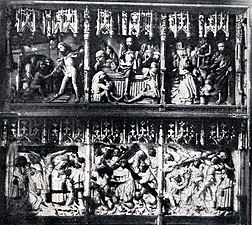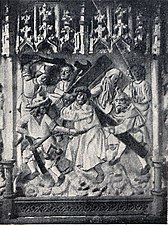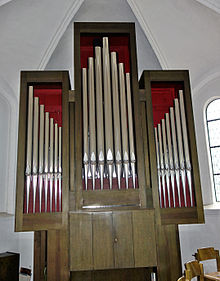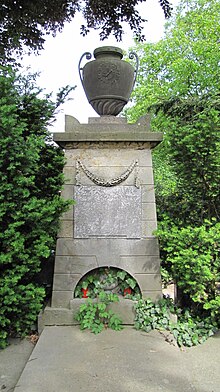St. Jürgen Chapel (Lübeck)
The St. Jürgen Chapel is a church in Lübeck .
location
The chapel is located in the St. Jürgen district, directly on the south-facing Ratzeburger Allee , not far from Wakenitz and in the immediate vicinity of the Wasserkunst site .
The predecessor

The Church is the successor building of built in 1290, St.-Jürgen-chapel to the immediately before Mühlentor located Siechenhaus belonged. The appearance of this first church building is passed down from a representation by Johannes Willinges from 1597 in the house of the merchants : It was a single-nave , rectangular building with a turret and a west facade designed as a stepped gable .
Since the infirmary was given legacies from wealthy Lübeck citizens, there have been documentary mentions of expansions, modifications and generous additions to the equipment since 1411. In 1505 the church received a wood-carved statue of its namesake St. Jürgen , which was created by Henning von der Heyde .
During the reign of Jürgen Wullenwever , the chapel and infirmary were, according to the written tradition of councilor Fritz Grawert , devastated and looted by incited supporters of the mayor on October 14, 1534, with a large part of the works of art and furnishings being destroyed and the building itself badly damaged. The statue of St. Jürgen, which was already considered valuable at the time, could be brought to safety beforehand, but the dragon had to be left behind, which was therefore destroyed. It was found in 1541 in the estate of Johann Sengestake , a merchant who had been promoted to councilor during the Wullenwever period and who, according to Grawert, had been involved in the unrest.
In the years 1540 to 1542 the church and infirmary were restored. The statue of St. George has been restored and returned to its old location; the carver Hinrich Wittekop made a replacement for the lost dragon, but it was clearly too small in relation to the other figures in the group.
The new St. Jürgen Chapel
In the twenties of the 17th century the events of the Thirty Years' War moved the Lübeck council to have the city's fortifications upgraded to the latest standards. The expansion of the bastions at the Mühlentor made it necessary to demolish the St. Jürgen Chapel, including the infirmary, and to rebuild it elsewhere. There was considerable resistance in the city to these plans; bad omens were even used as arguments against the demolition. Among other things, Superintendent Nikolaus Hunnius reported that the devil had appeared to him and took this as a sign that the plans were ominous.
Despite these protests, the council did not reverse its decision. On March 16, 1629, cathedral preacher Albert Reimers gave the last sermon in the old chapel, which was then dismantled over the following months.
The successor building was not built until 15 years later. In 1645 and 1646, together with the new infirmary, the St. Jürgen Chapel, which still exists today, was built less than a kilometer from the old location. The architect, city architect Andreas Jeger , designed a brick building that combined stylistic elements of the late Renaissance and the early Baroque and enriched it with Gothic quotations. The church with the plan in the form of a Greek cross received a separately standing wooden bell tower , in which the bell from the old chapel hangs. It was cast by Karsten Middeldorp in 1548 and is the oldest post-Reformation bell in Lübeck.
The dedication service was held on August 31, 1646; the sermon Adam Helms , senior pastor at St. Peter and as Senior of the Ministerium the Chief priest of the city, as organist acted Franz Tunder . For two centuries the chapel, which was only an independent branch church of Lübeck Cathedral without its own parish, served the inmates of the infirmary as a church; After the St. Jürgen Hospital was closed in 1847, the building was initially no longer used. It was not until 1880 that Bible studies were held, followed by regular church services, which became more popular after the chapel had a heating system in 1882 and gas lighting in 1885 . In 1886 the Lübeck Senate granted the chapel its own organ. From 1961, the St. Jürgen Chapel was no longer part of the cathedral, but was a parish church with its own congregation until the congregation merged with the other Protestant parishes in the district in 2002. The former St. Jürgen schoolhouse , built in 1834 by the St. Jürgen Siechen Foundation, served as the pastorate .
Furnishing
The statue of St. Jürgen was transferred to the chapel, but was then felt to be too old-fashioned and unsuitable for the new building. It was stored in the attic, where it was not found again until 1861. The work of art was brought to the Katharinenkirche and Carl Julius Milde carried out the restoration. It has been in the St. Annen Museum since 1915 .
The pulpit also comes from the old chapel. It was made in 1616 by the carpenter Johannes Warneke in the style of the late Renaissance . The pulpit is decorated with statuettes of the four evangelists in niches between Corinthian columns and tendril friezes. The pulpit was renovated together with the chapel in 1922.
The masonry altar table was covered by a 2.02 × 1.03 m medieval tombstone (from the cathedral?) From 1391. The center shrine of a Gothic passion retable from the southern Netherlands (around 1450) was placed on it. Since its restoration in 1647 and donation to St. Jürgen by the cathedral sexton Friedrich Leopold and his wife Elsabe, b. from Essen in memoriam Greveraden , the shrine may come from the Greveraden chapel of the cathedral. Its marble relief in the lower register is unique for Lübeck. The shrine was covered by a painting of the crucifixion in 1830, donated and probably also painted by Anna Dorothea Hornung. The Gothic altar panel was uncovered in 1916 and moved to the St. Anne's Museum .
- The 1916 find
At an unknown point in time, a small-format carved crucifixion group came into the chapel, which is dated to around 1520 . Crucifixion groups of this kind were particularly common in charitable institutions; so she could have come from the infirmary to the chapel.
organ
The St. Jürgen Chapel has an eventful organ history . The first instrument was built by Friedrich Albert Mehmel in 1886 and rebuilt in 1905 by the Lübeck organ builder Emanuel Kemper . From 1957–1976 the house organ by Hugo Distler was in the chapel . Today's organ was built in 1976 by the organ building company Hinrich Otto Paschen in Kiel. The slider chests -instrument has 18 registers on two manuals and pedal . The Spieltrakturen are mechanically, the Registertrakturen electrically.
|
|
|
||||||||||||||||||||||||||||||||||||||||||||||||||||||||||||||||||||||||||||||||||||||||||||||||||||||||
- Pairing : I / P, II / P
graveyards
The remains of the old cemetery are in the Am Brink green area near the Lübeck ramparts in front of the Mühlentor . The cemetery around the new chapel was occupied by the Lübeck cemetery reform movement beginning in the late 18th century, when some wealthy citizens demonstratively bought grave sites here, as happened west of the city in the cemetery of the St. Lorenzkirche , which is the center of this Movement made. Some beautiful tombs, which are under monument protection, testify to this time, the Souchay tomb was designed by the Danish architect Joseph Christian Lillie , to whom other tombs in the cemetery are ascribed.
The mortuary belonging to the cemetery with a small stepped gable on the rear part of the cemetery was built with the chapel, but was completed in 1645. The inconspicuous structure, today used as a bicycle workshop for a refugee project, is the oldest existing building in the St. Jürgen district.
literature
- Johannes Baltzer , Friedrich Bruns , Hugo Rahtgens: The architectural and art monuments of the Hanseatic city of Lübeck. Volume IV: The Monasteries. The town's smaller churches. The churches and chapels in the outskirts. Thought and way crosses and the Passion of Christ. Nöhring, Lübeck 1928 (facsimile reprint: Verl. Für Kunstreprod., Neustadt an der Aisch 2001, ISBN 3-89557-168-7 ), pp. 389-420
- Hartwig Beseler (ed.): Art topography Schleswig-Holstein. Neumünster 1974, pp. 158/159
- Uwe Albrecht , Ulrike Nürnberger, Jan Friedrich Richter , Jörg Rosenfeld, Christiane Saumweber: Corpus of medieval wood sculpture and panel painting in Schleswig-Holstein, Volume II: Hanseatic City of Lübeck, the works in the urban area. Ludwig, Kiel 2012, ISBN 3-933598-76-1
- Rolf König: The suburb of St. Jürgen . Schmidt-Römhild, 1998. ISBN 3-7950-1226-0
- Rainer Andresen: Lübeck - The old cityscape . Lübecker Rundschau, 1988
- Heinrich Christian Zietz : Views of the Free Hanseatic City of Lübeck and its surroundings. Frankfurt a. M. 1822, p. 108
Web links
Coordinates: 53 ° 51 ′ 11.2 " N , 10 ° 42 ′ 2.9" E
Individual evidence
- ↑ Alexandra Pietroch: St. Jürgen Group in: Jan Friedrich Richter (Ed.): Lübeck 1500 - Art Metropolis in the Baltic Sea Region , catalog, Imhoff, Petersberg 2015, pp. 196–199 (No. 14)
- ^ J. Warncke: The St. Jürgen Chapel in Lübeck and the Gothic carved altar found in it , in: Die christliche Kunst ; Monthly for all areas of Christian art and art history, 15th year (1918/19), pp. 32–34
- ^ Theodor Hach : Lübeck bell customer. Lübeck: Max Schmidt 1913 (publications on the history of the Free and Hanseatic City of Lübeck 2), p. 82
- ↑ Description in BuK IV, p. 411; apparently not in Klaus Krüger: Corpus of medieval grave monuments in Lübeck, Schleswig, Holstein and Lauenburg 1100-1600. Jan Thorbeke Verlag, Stuttgart 1999 ISBN 3-7995-5940-X
- ↑ Uwe Albrecht (ed.): Corpus of the medieval wood sculpture and panel painting in Schleswig-Holstein, Volume I: Hanseatic City of Lübeck, St. Annen Museum. Kiel: Ludwig, 2005. ISBN 3933598753 , No. 62, pp. 190-194
- ^ Uwe Albrecht, Ulrike Nürnberger, Jan Friedrich Richter, Jörg Rosenfeld, Christiane Saumweber: Corpus of medieval wood sculpture and panel painting in Schleswig-Holstein, Volume II: Hanseatic City of Lübeck, The works in the city area. Ludwig, Kiel 2012, ISBN 3-933598-76-1 , No. 106, pp. 336–338
- ↑ St. Jürgen. by Wilhelm Stahl In: Vaterstädtische Blätter , year 1922/23, No. 3, edition of November 5, 1922, p. 11.
- ↑ More information about the history and today's organ ( memento of the original from April 2, 2015 in the Internet Archive ) Info: The archive link was automatically inserted and not yet checked. Please check the original and archive link according to the instructions and then remove this notice.









